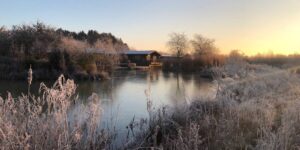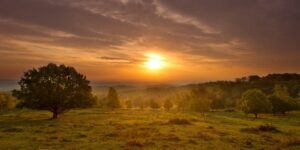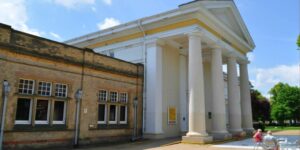

A landscape half a billion years in the making
Explore the landscape that inspired a young David Attenborough, boasting dormant volcanoes, fossils, amazing wildlife and beautiful views.
The setting for David Attenborough’s childhood adventures, Charnwood Forest’s unique landscape has an astonishing story to tell – one that spans 580 million years. The jagged outcrops explored by the naturalist-in-the-making are among the oldest rocks in England, but it’s the fossils found here that make it so special.
The rocks at Charnwood were thought to be too old to contain fossils but in 1957, a plant-like impression discovered embedded in stone here – named Charnia masoni – turned out to be the oldest fossilised evidence of our animal ancestors and changed our understanding of how complex life evolved on Earth.
As you explore Charnwood Forest, you’re walking back through time, and sites including Beacon Hill, Bradgate Park and Swithland Wood offer an other-worldly perspective when viewed at sunrise or sunset. Wander off the beaten track and you’ll discover wildflower meadows and quarries of slate and granite, the materials that give the surrounding villages their distinctive character.
Look out too for wildlife, with buzzards flying overhead, a bat population of regional importance and a canopy that’s home to many species of moths. The towering trees of Martinshaw Wood, between Ratby and Groby villages, offer a shaded pathway for walkers, and Groby Pool is home to one of Leicestershire’s few heronries.
Charnwood’s reservoirs also attract waterbirds, so on a stroll around the 3.5-mile stretch at Cropston, look for tufted duck and great-crested grebe. As you explore Thornton’s paths, set alongside National Forest woodland, you could even spot osprey competing with anglers for catch of the day at its trout fishery, which is open for fishing with a permit.
Hire a boat at Pillings Lock Marina on the Loughborough section of the Grand Union Canal, or head to Barrow-upon-Soar, where pedaloes and rowing boats at Barrow Boating offer an altogether different view of Charnwood. From here, a short journey to Leicester Museum and Art Gallery, where Charnia masoni is proudly displayed, will take you back nearly 600 million years.
Step back in time as you explore the woods and forests of this ancient landscape. From wildflower meadows to rare birds and trout fishing, the beautiful Leicestershire countryside was also once home to some of the oldest life on earth.
Piercing the landscape of Charnwood Forest are some of the oldest rocks in England, where fossils some 560 million years in the making caused scientists to rethink the beginnings of complex life on Earth. Charnwood’s villages have been shaped by this incredible geology, and its countryside lures historians, explorers and adventurers alike. The area boasts Leicestershire’s highest density of Sites of Special Scientific Interest, including Bradgate Park and Beacon Hill, and a Charnwood Peaks walk will guide you through a terrain of woodland and rocky outcrops.
From granites to slates these local stones have been quarried for centuries, and used to build many historic treasures that seem to sprout from their forest settings. Book a tour of Stoneywell cottage in Ulverscroft, a lasting legacy of Ernest Gimson and the Arts and Crafts’ back-to-nature philosophy, or glimpse the 13th century remains of Ulverscroft Priory.
With frequent reports of paranormal activity, the ruins of Augustinian nunnery Grace Dieu Priory near Thringstone, can be explored on a private tour by visiting gracedieupriory.org.uk. Nearby, in Coalville, Mount Saint Bernard Abbey was the first permanent monastery to be founded in England after the Reformation. Although private, you can visit its shop, where items for sale include Tynt Meadow, the UK’s first Trappist ale, brewed here by the monks. You can also climb to the abbey’s calvary, set atop a rocky outcrop rising above Charnwood’s canopy.
The setting for David Attenborough’s childhood adventures, Charnwood Forest’s unique landscape has an astonishing story to tell – one that spans 580 million years. The jagged outcrops explored by the naturalist-in-the-making are among the oldest rocks in England, but it’s the fossils found here that make it so special.
The rocks at Charnwood were thought to be too old to contain fossils but in 1957, a plant-like impression discovered embedded in stone here – named Charnia masoni – turned out to be the oldest fossilised evidence of our animal ancestors and changed our understanding of how complex life evolved on Earth.
As you explore Charnwood Forest, you’re walking back through time, and sites including Beacon Hill, Bradgate Park and Swithland Wood offer an other-worldly perspective when viewed at sunrise or sunset. Wander off the beaten track and you’ll discover wildflower meadows and quarries of slate and granite, the materials that give the surrounding villages their distinctive character.
Look out too for wildlife, with buzzards flying overhead, a bat population of regional importance and a canopy that’s home to many species of moths. The towering trees of Martinshaw Wood, between Ratby and Groby villages, offer a shaded pathway for walkers, and Groby Pool is home to one of Leicestershire’s few heronries.
Charnwood’s reservoirs also attract waterbirds, so on a stroll around the 3.5-mile stretch at Cropston, look for tufted duck and great-crested grebe. As you explore Thornton’s paths, set alongside National Forest woodland, you could even spot osprey competing with anglers for catch of the day at its trout fishery, which is open for fishing with a permit.
Hire a boat at Pillings Lock Marina on the Loughborough section of the Grand Union Canal, or head to Barrow-upon-Soar, where pedaloes and rowing boats at Barrow Boating offer an altogether different view of Charnwood. From here, a short journey to Leicester Museum and Art Gallery, where Charnia masoni is proudly displayed, will take you back nearly 600 million years.
Step back in time as you explore the woods and forests of this ancient landscape. From wildflower meadows to rare birds and trout fishing, the beautiful Leicestershire countryside was also once home to some of the oldest life on earth.
Piercing the landscape of Charnwood Forest are some of the oldest rocks in England, where fossils some 560 million years in the making caused scientists to rethink the beginnings of complex life on Earth. Charnwood’s villages have been shaped by this incredible geology, and its countryside lures historians, explorers and adventurers alike. The area boasts Leicestershire’s highest density of Sites of Special Scientific Interest, including Bradgate Park and Beacon Hill, and a Charnwood Peaks walk will guide you through a terrain of woodland and rocky outcrops.
From granites to slates these local stones have been quarried for centuries, and used to build many historic treasures that seem to sprout from their forest settings. Book a tour of Stoneywell cottage in Ulverscroft, a lasting legacy of Ernest Gimson and the Arts and Crafts’ back-to-nature philosophy, or glimpse the 13th century remains of Ulverscroft Priory.
With frequent reports of paranormal activity, the ruins of Augustinian nunnery Grace Dieu Priory near Thringstone, can be explored on a private tour by visiting gracedieupriory.org.uk. Nearby, in Coalville, Mount Saint Bernard Abbey was the first permanent monastery to be founded in England after the Reformation. Although private, you can visit its shop, where items for sale include Tynt Meadow, the UK’s first Trappist ale, brewed here by the monks. You can also climb to the abbey’s calvary, set atop a rocky outcrop rising above Charnwood’s canopy.

This is just one of many fascinating stories about Leicestershire's rich history, heritage, and culture. Discover more stories.
Features
Accessibility
Accessible parking or drop-off point







